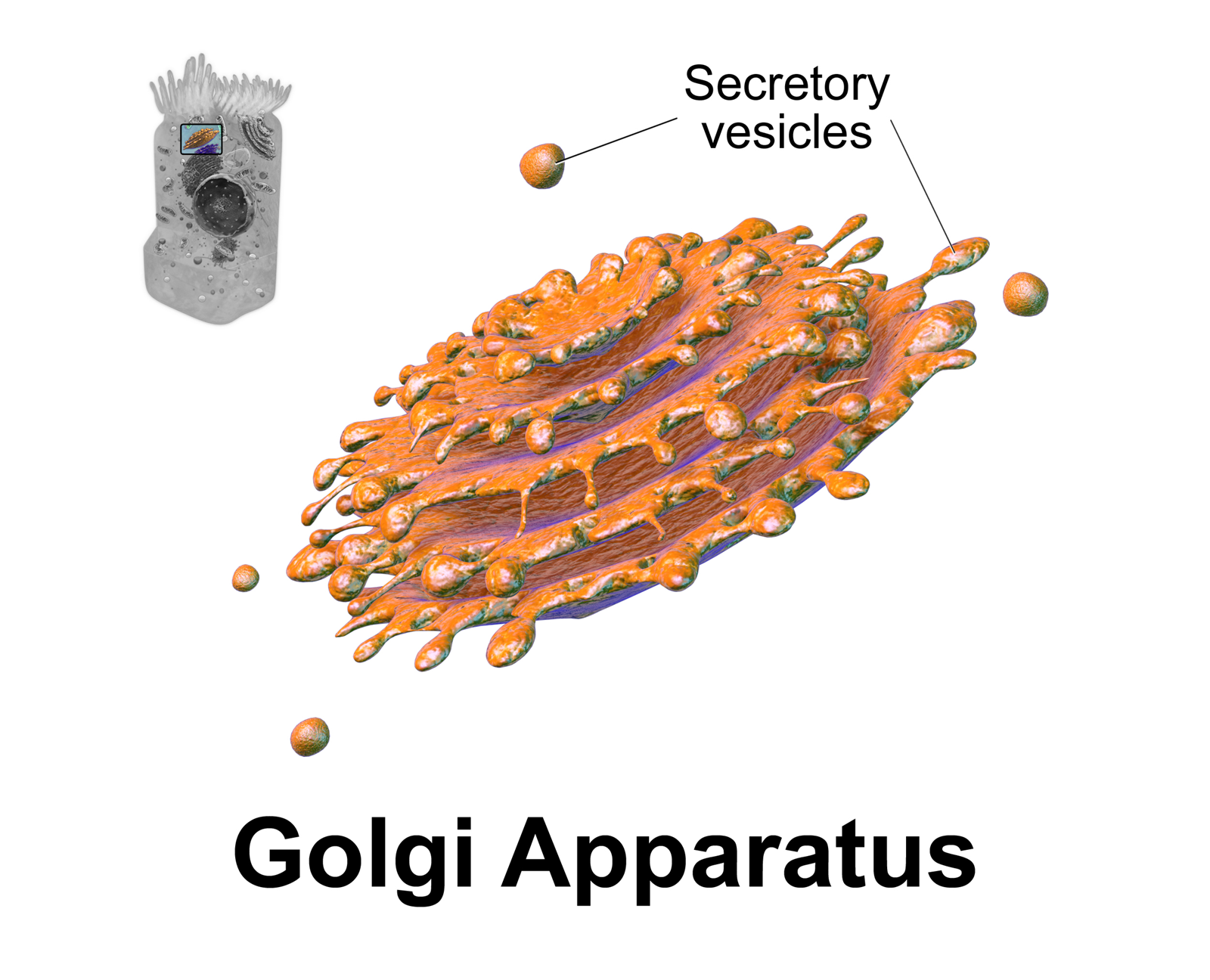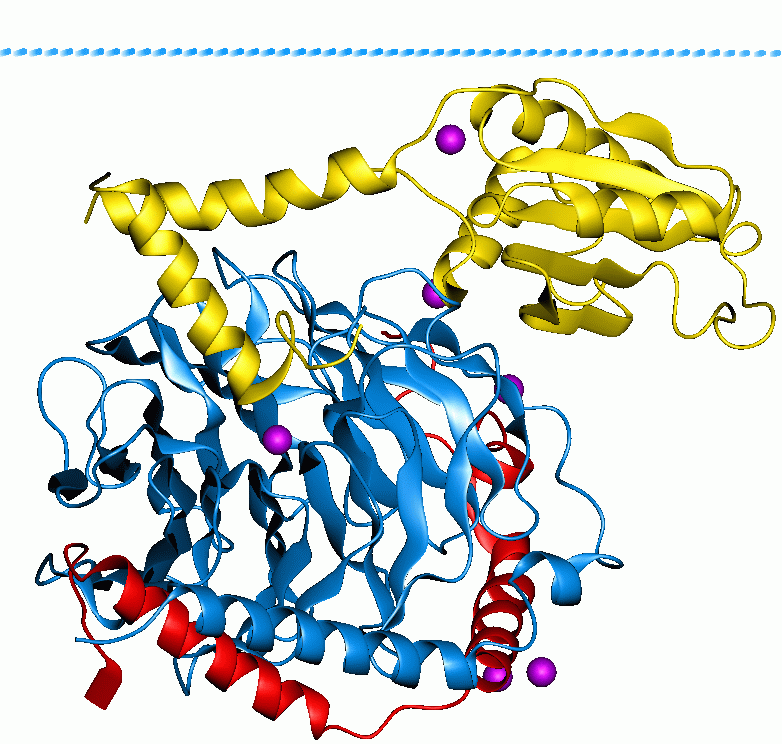|
Phosphatidylinositol 4-phosphate
Phosphatidylinositol-4-phosphate (PtdIns4''P'', PI-4-P, PI4P, or PIP) is a precursor of phosphatidylinositol (4,5)-bisphosphate. PtdIns4''P'' is prevalent in the membrane of the Golgi apparatus. In the Golgi apparatus, PtdIns4''P'' binds to the GTP-binding protein ARF and to effector proteins, including four-phosphate-adaptor protein 1 and 2 ( PLEKHA3 and PLEKHA8). This three molecule complex recruits proteins that need to be carried to the cell membrane. There is now evidence that PI-4-P is capable of deforming lipid systems into tightly curved assemblies, this is consistent with similar behaviour observed in phosphatidylinositol. See also * Phosphatidylinositol 3-phosphate * Phosphatidylinositol 5-phosphate * Phosphatidylinositol (3,4,5)-trisphosphate Phosphatidylinositol (3,4,5)-trisphosphate (PtdIns(3,4,5)''P''3), abbreviated PIP3, is the product of the class I phosphoinositide 3-kinases' (PI 3-kinases) phosphorylation of phosphatidylinositol (4,5)-bisphosphate (PIP2 ... [...More Info...] [...Related Items...] OR: [Wikipedia] [Google] [Baidu] |
Phosphatidylinositol (4,5)-bisphosphate
Phosphatidylinositol 4,5-bisphosphate or PtdIns(4,5)''P''2, also known simply as PIP2 or PI(4,5)P2, is a minor phospholipid component of cell membranes. PtdIns(4,5)''P''2 is enriched at the plasma membrane where it is a substrate for a number of important signaling proteins. PIP2 also forms lipid clusters that sort proteins. PIP2 is formed primarily by the type I phosphatidylinositol 4-phosphate 5-kinases from PI(4)P. In metazoans, PIP2 can also be formed by type II phosphatidylinositol 5-phosphate 4-kinases from PI(5)P. The fatty acids of PIP2 are variable in different species and tissues, but the most common fatty acids are stearic in position 1 and arachidonic in 2. Signaling pathways PIP2 is a part of many cellular signaling pathways, including PIP2 cycle, PI3K signalling, and PI5P metabolism. Recently, it has been found in the nucleus with unknown function. Functions Cytoskeleton dynamics near membranes PIP2 regulates the organization, polymerization, and bra ... [...More Info...] [...Related Items...] OR: [Wikipedia] [Google] [Baidu] |
Golgi Apparatus
The Golgi apparatus (), also known as the Golgi complex, Golgi body, or simply the Golgi, is an organelle found in most eukaryotic Cell (biology), cells. Part of the endomembrane system in the cytoplasm, it protein targeting, packages proteins into membrane-bound Vesicle (biology and chemistry), vesicles inside the cell before the vesicles are sent to their destination. It resides at the intersection of the secretory, lysosomal, and Endocytosis, endocytic pathways. It is of particular importance in processing proteins for secretion, containing a set of glycosylation enzymes that attach various sugar monomers to proteins as the proteins move through the apparatus. The Golgi apparatus was identified in 1898 by the Italian biologist and pathologist Camillo Golgi. The organelle was later named after him in the 1910s. Discovery Because of its large size and distinctive structure, the Golgi apparatus was one of the first organelles to be discovered and observed in detail. It was d ... [...More Info...] [...Related Items...] OR: [Wikipedia] [Google] [Baidu] |
GTP-binding Protein
G proteins, also known as guanine nucleotide-binding proteins, are a Protein family, family of proteins that act as molecular switches inside cells, and are involved in transmitting signals from a variety of stimuli outside a cell (biology), cell to its interior. Their activity is regulated by factors that control their ability to bind to and hydrolyze guanosine triphosphate (GTP) to guanosine diphosphate (GDP). When they are bound to GTP, they are 'on', and, when they are bound to GDP, they are 'off'. G proteins belong to the larger group of enzymes called GTPases. There are two classes of G proteins. The first function as monomeric small GTPases (small G-proteins), while the second function as heterotrimeric G protein protein complex, complexes. The latter class of complexes is made up of ''G alpha subunit, alpha'' (Gα), ''beta'' (Gβ) and ''gamma'' (Gγ) protein subunit, subunits. In addition, the beta and gamma subunits can form a stable Protein dimer, dimeric complex re ... [...More Info...] [...Related Items...] OR: [Wikipedia] [Google] [Baidu] |
ADP Ribosylation Factor
ADP ribosylation factors (ARFs) are members of the ARF family of GTP-binding proteins of the Ras superfamily. ARF family proteins are ubiquitous in eukaryotic cells, and six highly conserved members of the family have been identified in mammalian cells. Although ARFs are soluble, they generally associate with membranes because of N-terminus myristoylation. They function as regulators of vesicular traffic and actin remodelling. The small ADP ribosylation factor (Arf) GTP-binding proteins are major regulators of vesicle biogenesis in intracellular traffic. They are the founding members of a growing family that includes Arl (Arf-like), Arp (Arf-related proteins) and the remotely related Sar (Secretion-associated and Ras-related) proteins. Arf proteins cycle between inactive GDP-bound and active GTP-bound forms that bind selectively to effectors. The classical structural GDP/GTP switch is characterised by conformational changes at the so-called switch 1 and switch 2 regions, wh ... [...More Info...] [...Related Items...] OR: [Wikipedia] [Google] [Baidu] |
Effector Protein
In biology, an effector is a general term that can refer to several types of molecules or cells. In the context of biological system regulation, an effector is an element of a regulation loop controlling a regulated quantity. Small molecule effectors * A small molecule that selectively binds to a protein to regulate its biological activity can be called an effector. In this manner, effector molecules act as ligands that can increase or decrease enzyme activity, gene expression, influence cell signaling, or other protein functions. An example of such an effector is oxygen, which is an allosteric effector of hemoglobin - oxygen binding to one of the four hemoglobin subunits greatly increases the affinity of the rest of the subunits to oxygen. Certain drug molecules also fall into this category - for example the antibiotic rifampicin used in the treatment of tuberculosis binds the initiation σ factor subunit of the bacterial RNA polymerase, preventing the transcription of bacte ... [...More Info...] [...Related Items...] OR: [Wikipedia] [Google] [Baidu] |
PLEKHA8
Pleckstrin homology domain containing A8 is a protein that in humans is encoded by the PLEKHA8 gene In biology, the word gene has two meanings. The Mendelian gene is a basic unit of heredity. The molecular gene is a sequence of nucleotides in DNA that is transcribed to produce a functional RNA. There are two types of molecular genes: protei .... References Further reading * * * * * * * {{gene-7-stub ... [...More Info...] [...Related Items...] OR: [Wikipedia] [Google] [Baidu] |
Cell Membrane
The cell membrane (also known as the plasma membrane or cytoplasmic membrane, and historically referred to as the plasmalemma) is a biological membrane that separates and protects the interior of a cell from the outside environment (the extracellular space). The cell membrane consists of a lipid bilayer, made up of two layers of phospholipids with cholesterols (a lipid component) interspersed between them, maintaining appropriate membrane fluidity at various temperatures. The membrane also contains membrane proteins, including integral proteins that span the membrane and serve as membrane transporters, and peripheral proteins that loosely attach to the outer (peripheral) side of the cell membrane, acting as enzymes to facilitate interaction with the cell's environment. Glycolipids embedded in the outer lipid layer serve a similar purpose. The cell membrane controls the movement of substances in and out of a cell, being selectively permeable to ions and organic mole ... [...More Info...] [...Related Items...] OR: [Wikipedia] [Google] [Baidu] |
Phosphatidylinositol
Phosphatidylinositol or inositol phospholipid is a biomolecule. It was initially called "inosite" when it was discovered by Léon Maquenne and Johann Joseph von Scherer in the late 19th century. It was discovered in bacteria but later also found in eukaryotes, and was found to be a signaling molecule. The biomolecule can exist in 9 different isomers. It is a lipid which contains a phosphate group, two fatty acid chains, and one inositol sugar molecule. Typically, the phosphate group has a negative charge (at physiological pH values). As a result, the molecule is amphiphilic. The production of the molecule is limited to the endoplasmic reticulum. History of phospatidylinositol Phosphatidylinositol (PI) and its derivatives have a rich history dating back to their discovery by Johann Joseph von Scherer and Léon Maquenne in the late 19th century. Initially known as " inosite" based on its sweet taste, the isolation and characterization of inositol laid the groundwork for und ... [...More Info...] [...Related Items...] OR: [Wikipedia] [Google] [Baidu] |
Phosphatidylinositol 3-phosphate
Phosphatidylinositol 3-phosphate (PI3P) is a phospholipid found in cell membranes that helps to recruit a range of proteins, many of which are involved in protein trafficking, to the membranes. It is the product of both the class II and III phosphoinositide 3-kinases (PI 3-kinases) activity on phosphatidylinositol. PtdIns3''P'' is dephosphorylated by the myotubularin family of phosphatase In biochemistry, a phosphatase is an enzyme that uses water to cleave a phosphoric acid Ester, monoester into a phosphate ion and an Alcohol (chemistry), alcohol. Because a phosphatase enzyme catalysis, catalyzes the hydrolysis of its Substrate ...s, on the D3 position of the inositol ring, and can be converted to PtdIns(3,5)''P''2 by the lipid kinase PIKfyve. Both FYVE domains and PX domains – found in proteins such as SNX1, HGS, and EEA1 – bind to PtdIns3''P''. The majority of PtdIns3''P'' appears to be constitutively synthesised by the class III PI 3-kinase, PIK3C3 ... [...More Info...] [...Related Items...] OR: [Wikipedia] [Google] [Baidu] |




